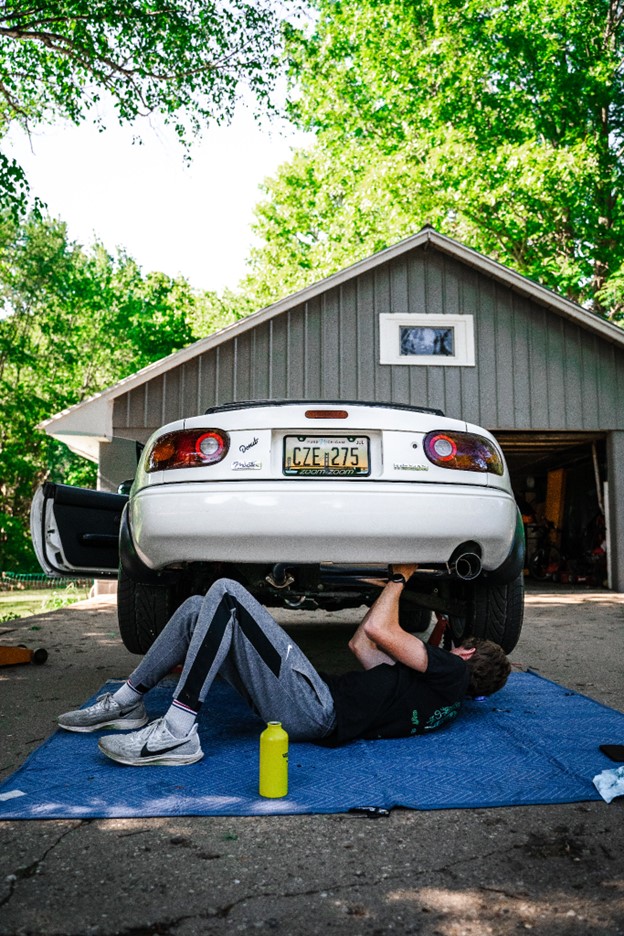A key focus of my blog is Financial Literacy/Money. A major expense for everyone is their car. Likewise, it’s important to understand what and when to pay for these expenses. The following contributed post is entitled, The Frugal Road: Strategic Investments in Your Car.
* * *
In a world often equating frugality with cheapness, it’s crucial to grasp the nuanced difference. Frugality is not about scrimping but making wise, long-term investments. This principle holds especially true in the realm of transportation, where strategic investments in your car can embody the true essence of financial prudence.

Beyond Cheapness – Understanding Frugality
Frugality, often misunderstood, is a financial philosophy grounded in resourcefulness and wise spending. It’s about making choices that yield long-term value, a principle that sets it apart from mere penny-pinching.
So, it becomes crucial to make a distinction between cheapness and frugality. Being frugal as a car owner is not the same thing as being cheap. While cheapness often connotes a focus solely on low costs, frugality entails making thoughtful, value-driven choices. The benefits of embracing frugality extend beyond immediate savings; it’s a strategic approach that emphasizes long-term value.
In the context of vehicle ownership, being frugal involves thoughtful investments to ensure sustained value and reliability. As a car owner, embodying a frugal mindset translates to making careful investments rather than indiscriminate cutbacks. It’s about understanding that maintenance is an investment, not an expense. By adopting frugality in car ownership, you navigate a path where judicious spending preserves your vehicle’s value without draining your finances. This nuanced approach acknowledges that being frugal isn’t about sacrificing quality; instead, it’s a savvy way to ensure your car remains a reliable asset without unnecessarily breaking the bank.
Driving Culture in the USA – The Indispensability of Cars
The United States’ pervasive driving culture makes cars not just a luxury but a necessity. The average car owner in the United States drives over 14,000 miles every year according to the Federal Highway Administration. For perspective, this is the equivalent of driving 300 miles a week. In a country where you have to drive everywhere, the importance of investing in your vehicle goes beyond convenience. It becomes a crucial aspect of financial prudence and responsible ownership.
In the United States, the car is more than a mode of transportation; it is an indispensable tool that supports every American through their everyday life needs. From commuting to work to pursuing leisure activities, cars are an integral part of the American culture because there isn’t any other alternative for many Americans.
Not having a car poses significant risks to one’s livelihood, impacting the ability to fulfill professional duties and engage in routine activities.
As a result, maintaining a car in the USA isn’t just about mobility; it’s a strategic necessity. Being frugal isn’t just about adhering to a budget; it’s a smart approach that allows individuals to safeguard their vehicles without compromising financial stability. This balance ensures that the essential investment in a car aligns harmoniously with budgetary constraints, promoting both reliability and financial well-being.
DIY Repairs – The Gateway to Long-Term Savings
Learning basic repair works, from changing lights to inspecting and replacing brakes, empowers car owners to save significantly. But first things first: DIY repairs does not mean grabbing the first tool you find and hoping for the best. You need to equip yourself with the right knowledge and tools if you are going to save costs through your repair works. Simple tasks like changing lights, inspecting brakes, or even replacing air filters can be undertaken at home, saving both time and money.
Once again, understanding how to execute these repairs safely is paramount. It not only ensures the well-being of the car owner but also contributes to the longevity and efficiency of the vehicle. The main reason why DIY repairs fail is because car owners do not take the time to learn. Learning the basics of DIY repairs fosters a sense of independence and self-reliance, reducing reliance on costly professional services and enabling you to diagnose and fix simple issues.
The financial benefits are substantial. DIY repairs eliminate labor costs associated with professional mechanics, making it a pocket-friendly alternative. Besides, a proactive approach to maintenance car not only save on immediate expenses but also avert potential major issues, ultimately securing long-term savings and enhancing the overall reliability of their vehicles.
The financial benefits of undertaking these tasks personally, rather than resorting to expensive garage services, exemplify the true spirit of frugality.
However, there are some repairs that you’re still going to need help with. For example, some transmission repairs are better off in the hands of a professional, as they can be quite complex. It’s better not to risk getting these things wrong, as you could end up in the garage anyway if they do.
Road Safety Investments – Follow the Manufacturer’s Recommendations
Ensuring road safety involves strategic investments, such as regular tire changes and adherence to manufacturers’ recommendations. While these may seem like upfront costs, they are preventive measures that safeguard against potential accidents and breakdowns, ultimately translating to long-term financial savings.
The key to road safety maintenance is to adhere to the manufacturer’s recommendations. While this is a crucial aspect of responsible car ownership, many drivers are keen to postpone servicing and maintenance. These recommendations, often including scheduled check-ups and component replacements, serve as a blueprint for preserving your vehicle’s health.
So it is paramount to view these guidelines as investments rather than mere obligations. Regular maintenance, such as changing timing belts and oil filters as advised, safeguards the intricate components of your vehicle. It’s a proactive measure that pays dividends, prolonging the value of your car and preventing potential breakdowns.
Another essential road safety investment, aligned with the manufacturer’s guidelines, includes timely tire replacements. Typically, the manufacturer’s manual will provide information about the best choice of tires and tire size. As such, new tires in the appropriate size and model will ensure optimal traction and stability, enhancing safety on the road, even though other options may appear cheaper at first. Equipping your vehicle with the wrong tire models can and will have dramatic consequences on your driving safety and on maintaining the long-term value of the vehicle.
In conclusion, there is no denying that owning a car comes with costs. Yet, being frugal in car ownership isn’t about cutting corners; it’s about making informed and prudent decisions that maximize the overall value and longevity of your vehicle. Saving money as a car owner isn’t about postponing essential work or repairs on your car. It is precisely a case of understanding what needs to be done to keep your vehicle on the road.
From DIY repairs to adhering to manufacturer’s guidelines, each investment plays a role in enhancing your car’s reliability and preserving your financial well-being on the road.







